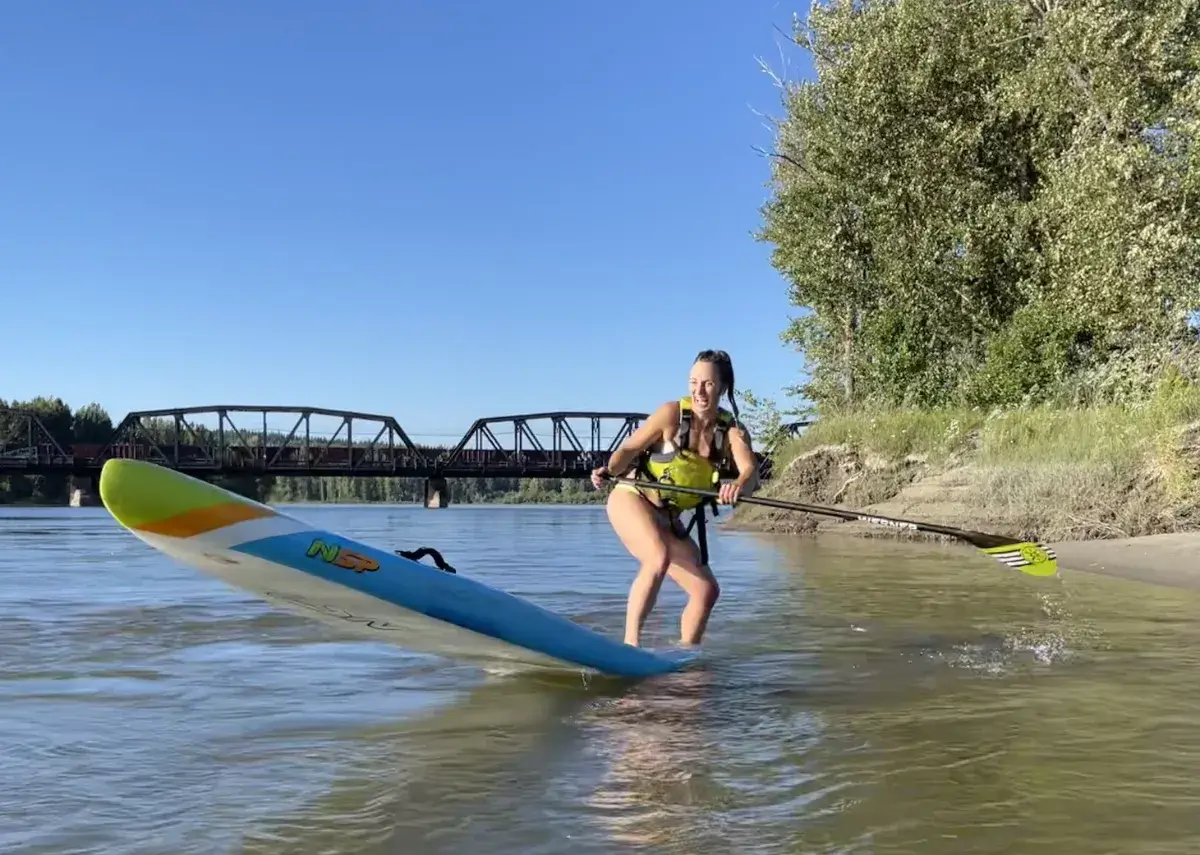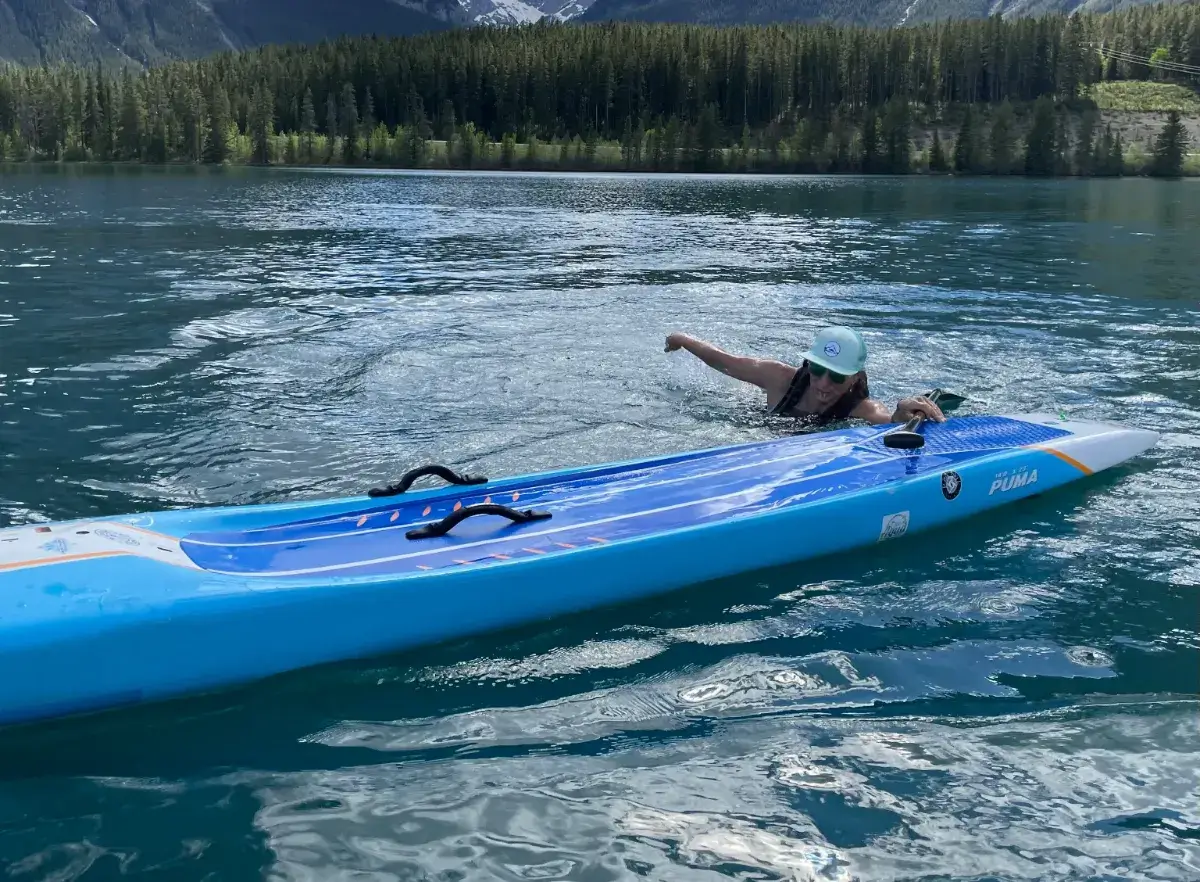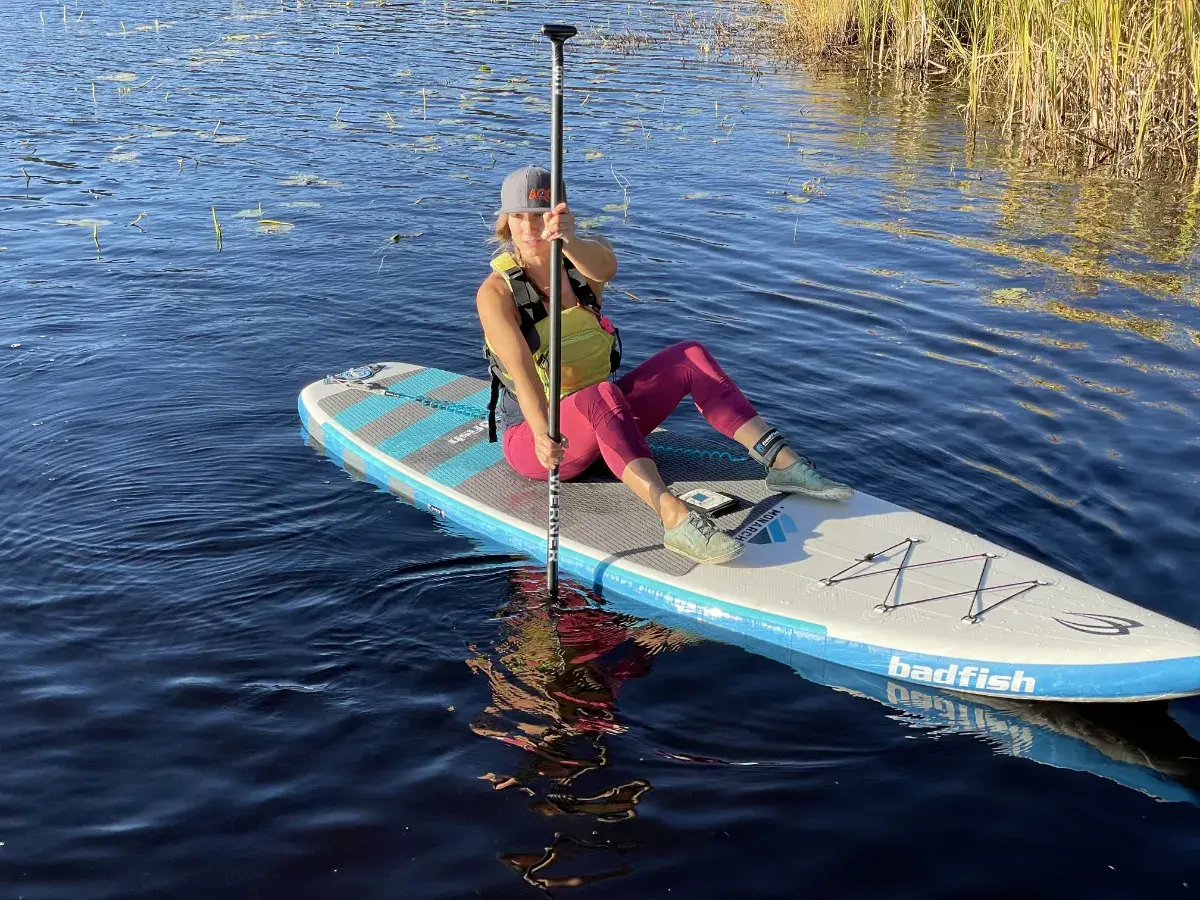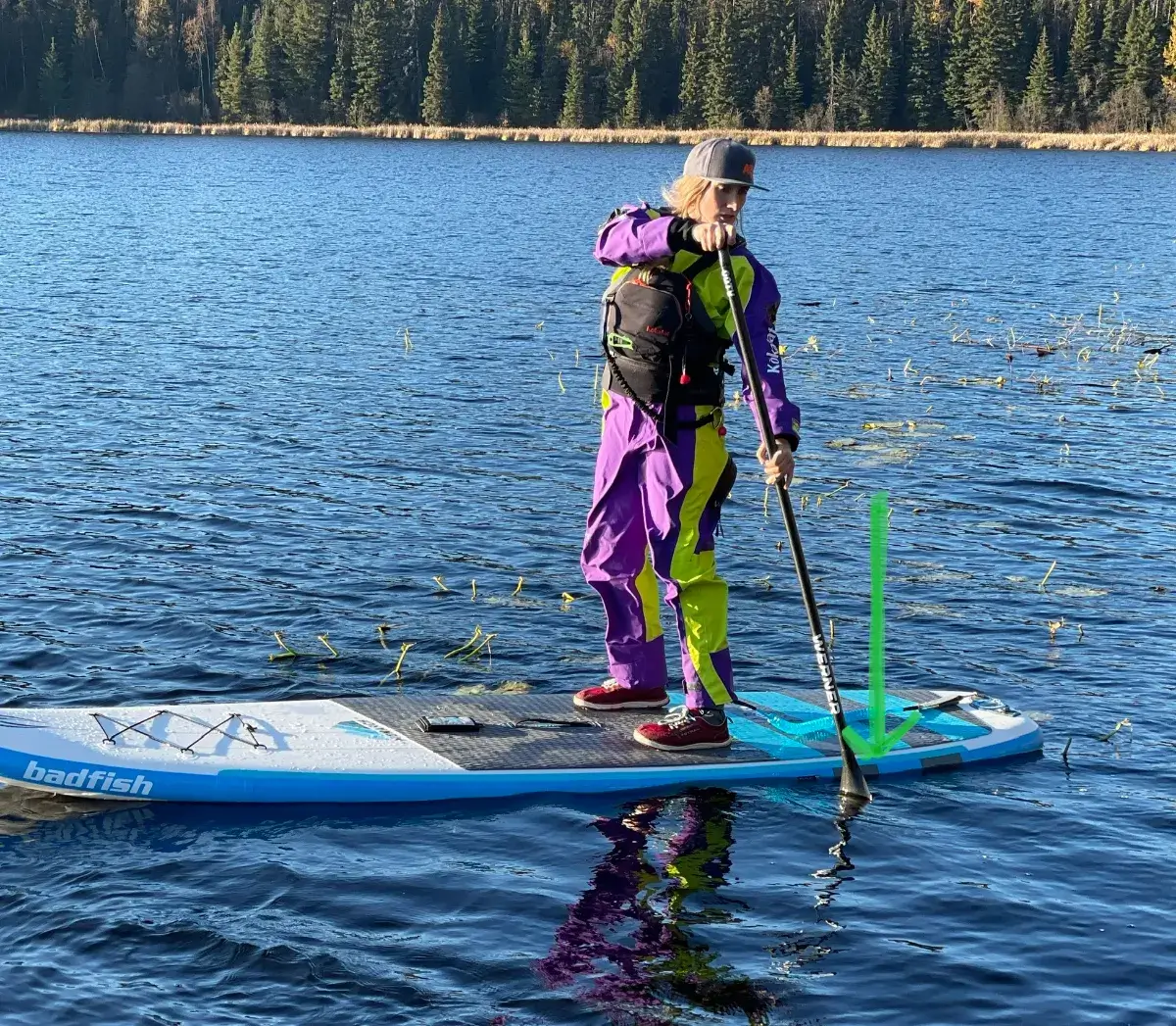Hi! My name's Kimberley Kenyon and I'm an experienced flatwater paddleboard racer and and whitewater paddleboarder. This is my complete guide for “How to Stand Up Paddle Board”.
I'll start off by going through the minimum gear you need to start paddleboarding on your own, including safety gear. Then I'll go through all the core skills you need to make the most of your time on the water!
I have separate articles linked for each core skill, so you can explore them in depth. This article is meant as a basic overview and guide to help you focus in on what your really need to know.
Shop AQ Outdoors SUP Collection
How to Stand Up Paddleboard
Equipment
Paddleboard
This is probably the question newcomers ask the most: what kind of equipment do I need before I can stand up paddleboard?!
To get out on the water on your own you will need a stand up paddleboard, a paddle, a leash, and fins for the board (if your paddleboard doesn't come with them).
Paddleboards themselves come in hard and soft/inflatable styles. Inflatable paddleboards are the most versatile because there's less worry about scratches and dings, and they are much easier to transport.
However, if you're not concerned about transporting your paddleboard, and only plan on paddling lakes, then a hardboard is a suitable option.
For more insight, check out Hardboard vs Inflatable SUP: Which is Better?
[Read More: How to Choose a Stand Up Paddleboard]
[Read More: Best Inflatable Paddleboards 2023]
Paddle
The next important piece of gear is a paddle. With paddles, they typically go up in price as they become lighter and stiffer.
Plastic is at the bottom of the list for performance, but the most affordable. Fibreglass is in the middle of the pack. Carbon is your most expensive paddle material option, but is the lightest and stiffest. These characteristics save you energy for longer days, or if you plan on competing.
There are also options for a kayak that is a single piece, vs one that breaks down to smaller pieces. A break-down paddle is easier to transport, but costs more.
For more guidance on choosing a stand up paddleboard paddle, check out [Werner SUP Paddle | How to Choose the Right One]
Paddleboard Leash
Depending on what kind of SUP you're doing (flatwater vs moving water vs surf) you may want to consider a quick-release leash that keeps your paddle board close to you, but enables you to get rid of it quick if you need to swim to safety.
For more information check out [Everything About SUP Leashes]
Safety
Staying safe while stand up paddle boarding involves wearing and carrying the right safety equipment, making a plan, and having a few basic safety skills.
This is Transport Canada's safety gear list for paddleboards:
For more information, check out the Transport Canada Safe Boating Guide
Depending on the water temperatures, thermal protection is also a great addition to the safety equipment, this can be anything from a lightweight neoprene wet suit to a fully sealed drysuit.
To browse our full collections, check out the links below:
Shop SUP Insulation/Layers Collection
Another core piece of safety is planning your trip. Do you know the section of water you're paddling? Do you know alternate exit points if the weather turns? Have you checked the weather?
These are some important questions to answer before you hop on the water. Check out the full list below:
- A plan before, during and after is an essential piece to getting on the water.
- Plan ahead and check the weather.
- Choose where the location is for paddling.
- Decide who is going with.
- What is the general route planned to be paddled?
- When are you starting paddling and when is the plan to be off the water?
- More importantly, did you set up a check in with this information?
There are also some basic safety skills that are good to know, including getting back on the board and different paddling positions such as prone and knee paddling.
To learn everything you need to know about SUP, or to advance your skills, then check out our industry leading stand up paddleboard courses:
Basic SUP Safety Skills
Self rescue- [How to Get Back on Your Paddleboard]
It can be tricky finding your balance when you first start out SUPing, so you'll likely get plenty of practice with this skill.
This is one to continue practicing to become more efficient, because you never know when you might fall off away from shore and the more energy you can save getting back on your board, and the quicker you can do it, then the warmer you'll be.
Alternate Paddling Positions
It's a great idea to practice paddling in different positions. This not only helps develop your board-sense, and technique, but gives you some valuable options to paddle back to shore if you're caught in turbulent water too difficult to stand up on, you get tired, or injured.
To learn more, check out [Prone and Knee Paddling Positions]
Paddleboard Skills
Learning the skills involved with stand up paddle boarding is like learning any other sport. There is a progression starting with learning how to stand and get your board onto the water. There are a few different techniques to getting to your feet and some great tips on launching and landing.
There are more than a handful of paddle strokes to learn while progressing in the sport. The first stroke to learn is the forward stroke which propels the board forward and straight. Next is learning how to turn and manoeuvre using the different turning strokes, such as the sweep stroke and draw stroke.
Don't forget how to stop with a resverse stroke. Once you have mastered some board control, learners can move into more advanced skills in order to move their feet, engage their edges and turn the board quickly using a pivot turn.
Sizing your Paddle
Information is at the beginning of [this article about SUP Paddle Technique]
Standing Up
Detailed post coming soon.
Launching and Landing
To learn how best to get into the water, and out of it, without damaging your paddleboard and staying balanced, then check out [How to Launch and Land]
Switching Sides
Paddling on either side of your paddle board is a great skill to have as it helps keep you on your line, and gives you options if your arms get sore on one side.
Forward Stroke
The basic, fundamental SUP paddling stroke you'll use more than any other.
[Forward stroke - Going Straight and Forwards]
Reverse Stroke
This paddle technique helps slow you down if you need to make a tight turn or if you're headed in the wrong direction, and can also be used to help steer.
[Reverse Stroke - Braking and Turning]
Sweep Stroke
The sweep stroke is an efficient technique to keep you pointed in the right direction without losing momentum or speed.
Draw Stroke
This paddle technique helps you move laterally from side to side and is another option to help keep you on your line.
[Draw Stroke- How to Move Your Paddleboard Sideways Safely]
Advanced Draw Stroke
Similar to the basic stroke, this technique adds an extra element -- using momentum to help turn your board. This is especially helpful if you're moving fast, or on whitewater.
[Advanced Draw Stroke - Turning Towards the Paddling Side, Using Momentum to Turn]
Edging
This involves weighting the board to utilize its edges, which is helpful for developing balance, and turning the board quicker. Detailed blog post coming soon.
SUP Foot Stances
Once you get more comfortable on your board and want to start paddling more aggressivley, your foot position can have a big impact on how your board reacts on the water.
[SUP Stances - Where to Put Your Feet and Why]
Pivot Turns
This is an advanced technique and often seen in races. Detailed blog post coming soon.
How to Stand Up Paddleboard Conclusion
Whether it be a simple lake paddle, a multi-day adventure, or running wild river rapids, learning how to paddle board is an ever evolving experience. It's recommended for a learner to start with the safety basics and requirements. They can add in some skills for board control and slowly progress within their own comfort to explore and experience the unbelievable freedom of this growing sport.
“Dreams don’t work unless you do”
Kimberley Kenyon
Badfish Team Athlete
Kokatat Team Athlete
AQ Outdoors Whitewater SUP
Advanced and River 1 SUP Instructor Paddle Canada
@borntoboard.ca
Shop AQ Outdoors SUP Collection
AQ Outdoors Contact
Edmonton: (p) 780 463-4892 (e) info@aquabaticsedmonton.com
Calgary: (p) 403 288-9283 (e) info@aqoutdoors.com








































































